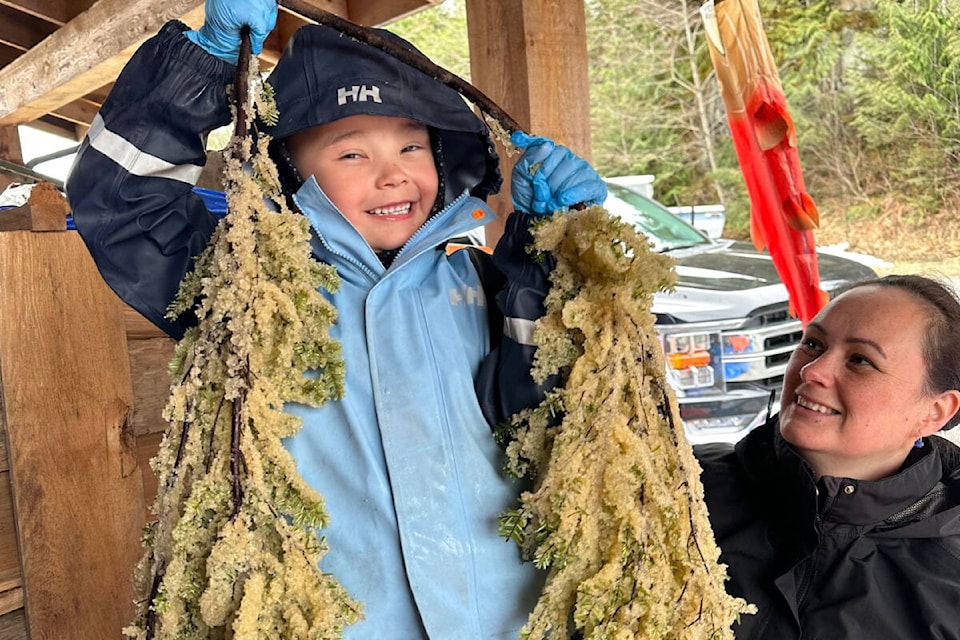While some are harvesting gardens and fields, others are heading under the sea for their foraging.
In Bella Bella, B.C., William Housty pulls kelp covered with herring spawn, providing a tasty and nutritious snack or meal.
You can consume kelp in many ways, if not when it’s fresh and raw. You can dehydrate the kelp and later enjoy it with smoked salmon; it can be fried with butter and garlic; you can boil it with oolichan grease; or it can be incorporated into seafood chowder, said Housty, who is the conservation manager at the Heiltsuk Integrated Resource Management Department.
Kelp is excellent for its high nutritional value and grows quickly from all the sunlight it can absorb.
“It’s like eating vitamins.”
Kelp also doubles as a place for herring to deposit their eggs, which are also loaded with nutrients.
“Kelp have kind of slimy texture to them, so the herring like to spawn on the kelp because it sticks to the substrate really easily, and so it’s more of a sure guarantee for the herring, as the eggs are going to stay deposited and not be pulled off by the tide or anything like that.”
Housty harvests kelp for his family’s consumption and for the local fishery, where Heiltsuk band members can participate with the fishery once they’re over 18.
“It’s a source of income for a lot of people in the community,” said Housty, and a practise his ancestors have been doing for thousands of years.
“Back in 1996, there was a Supreme Court decision that granted the Heiltsuk to be able to commercially harvest the herring spawn on kelp, and so we’re the only tribe on the B.C. coast that’s legally able to harvest the spawn on the kelp for commercial sale.”
Along with personal and commercial harvesting for food, kelp is also used within the Heiltsuk Nation for social and ceremonial purposes.
In Bella Bella, which is on Campbell Island, Housty described the volume of kelp in the water as a parking lot, with “large masses and concentrations of different species.”
He explained that the harvesting season happens over a small window, from about the middle of March to mid-April, depending on the tides, weather and temperature. The herring come in late February and disperse to the spawning areas in March.
The females deposit their eggs – on the kelp, rocks and trees – and then the males fertilize the eggs, causing the water to turn a milky colour.
Next, the seaweed farmers head out onto the water in search of the highest quality kelp, which won’t have holes or rip, said Housty.
“When you break it off, it makes a kind of loud snapping noise, and that shows how healthy the individual is. We never pull the root off the rock. We always break it off because it regrows almost instantaneously, you know. It only takes a couple of weeks, and the kelp regrows back to what it was when you snapped it off.”
The harvest is quite incredible, as the kelp pulled out of the water will appear to be over double in size, which in reality is from the number of roe deposited onto the kelp’s branches. Housty described the roe as a golden yellow colour, with the kelp being more of a brown colour.
“It’s really soft when it’s fresh out of the water. You can pull it apart with your fingers quite easily. Like the same way you could pull apart a piece of bread, you could pull the eggs apart.”
Along with Housty’s wife, Faye, their sons also help out. His youngest son, George, helps out along the shore; his middle son, Landon, helps out in the boat; and his oldest son, Ethan, helped out with harvesting before moving to Haida Gwaii.
“It feels great to be harvesting and being on the water because we are carrying on the harvesting tradition that has been handed down through the generations by our ancestors. Lots of pride.”
READ MORE:
READ MORE:
kim.kimberlin@blackpress.ca
Like us on and follow us on



